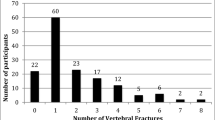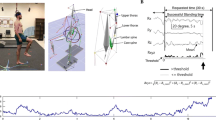Abstract
Summary
The association between posture and physical function during daily activities in people at risk for osteoporotic fracture is not clear. We report the reliability of measuring posture using the digital inclinometer and how these measures relate to performance-based and self-reported physical function.
Introduction
This study aims to determine the reliability of a simple clinical method for assessing spine curvatures in people with low bone mass and the association between spine curvature measures and pain, physical function (mobility/activities of daily living (ADL)) and quality of life.
Methods
One rater assessed 36 high-functioning adults, aged 52–82 years, attending an outpatient osteoporosis clinic. A digital inclinometer was used to measure lumbosacral angle (S), lumbar standing posture (L), and thoracic standing posture (T) and ADL performance was assessed using the short form of the Safe Functional Motion test (SFM-6), on two occasions approximately 8.7 days apart. Participants reported average pain intensity over the past week and completed the Timed Up and Go test (TUGT) and the mini-Osteoporosis Quality of Life questionnaire (mini-OQLQ). Acceptable reliability was determined using the intraclass correlation coefficient (ICC). Associations were determined using Pearson’s correlation coefficients (r) (and Spearman’s rho (r s), for non-normal data).
Results
ICC (95 % CI) for S, L, and T = 0.91 (0.82, 0.95), 0.90 (0.82, 0.95), and 0.91 (0.84, 0.95), respectively, for test–retest reliability. Thoracic standing posture was associated with the ADL domain of the mini-OQLQ (r s = −0.39) and the TUGT (r = 0.42). Standing posture was not related to pain or total SFM-6 score.
Conclusions
Digital inclinometer measures provide a quick highly reliable, valid, direct assessment of kyphosis. Use of these measures in the clinical setting is expected to facilitate identification and effective management of postural impairments (e.g., trunk extensor muscle weakness, vertebral fracture) associated with osteoporosis.
Similar content being viewed by others
References
Nishiwaki Y, Kikuchi Y, Araya K, Okamoto M, Miyaguchi S, Yoshioka N, Shimada N, Nakashima H, Uemura T, Omae K, Takebayashi T (2007) Association of thoracic kyphosis with subjective poor health, functional activity and blood pressure in the community-dwelling elderly. Environ Health Prev Med 12:246–250
Manns RA, Haddaway MJ, McCall IW, Cassar Pullicino V, Davie MWJ (1996) The relative contribution of disc and vertebral morphometry to the angle of kyphosis in asymptomatic subjects. Clin Radiol 51:258–262. doi:10.1016/S0009-9260(96)80342-4
De Smet AA, Robinson RG, Johnson BE, Lukert BP (1988) Spinal compression fractures in osteoporotic women: patterns and relationship to hyperkyphosis. Radiology 166:497–500
Itoi E, Sinaki M (1994) Effect of back-strengthening exercise on posture in healthy women 49 to 65 years of age. Mayo Clin Proc 69:1054–1059
Sinaki M, Itoi E, Rogers JW, Bergstralh EJ, Wahner HW (1996) Correlation of back extensor strength with thoracic kyphosis and lumbar lordosis in estrogen-deficient women. Am J Phys Med Rehabil 75:370–374
Briggs AM, Wrigley TV, van Dieen JH, Phillips B, Lo SK, Greig AM, Bennell KL (2006) The effect of osteoporotic vertebral fracture on predicted spinal loads in vivo. Eur Spine J 15:1785–1795. doi:10.1007/s00586-006-0158-0
Harrison RA, Siminoski K, Vethanayagam D, Majumdar SR (2007) Osteoporosis-related kyphosis and impairments in pulmonary function: a systematic review. J Bone Miner Res 22:447–457
Chow SB, Moffat M (2004) Relationship of thoracic kyphosis to functional reach and lower-extremity joint range of motion and muscle length in women with osteoporosis or osteopenia: a pilot study. Top Geriatr Rehabil 20:297–306
Katzman WB, Wanek L, Shepherd JA, Sellmeyer DE (2010) Age-related hyperkyphosis: Its causes, consequences, and management. J Orthop Sports Phys Ther 40:352–360
Cook C (2003) The relationship between posture and balance disturbances in women with osteoporosis. Phys Occup Ther Geriatr 20:37–49
Siminoski K, Warshawski RS, Jen H, Lee KC (2011) The accuracy of clinical kyphosis examination for detection of thoracic vertebral fractures: comparison of direct and indirect kyphosis measures. J Musculoskelet Neuronal Interact 11:249–256
Sinaki M, Itoi E, Wahner HW, Wollan P, Gelzcer R, Mullan BP, Collins DA, Hodgson SF (2002) Stronger back muscles reduce the incidence of vertebral fractures: a prospective 10 year follow-up of postmenopausal women. Bone 30:836–841
Cieza A, Schwarzkopf S, Sigl T, Stucki G, Melvin J, Stoll T, Woolf A, Kostanjsek N, Walsh N (2004) ICF Core Sets for osteoporosis. J Rehabil Med 44(Suppl):81–86
Bonner FJ Jr, Sinaki M, Grabois M, Shipp KM, Lane JM, Lindsay R, Gold DT, Cosman F, Bouxsein ML, Weinstein JN, Gallagher RM, Melton LJ III, Salcido R, Gordon SL (2003) Health professional’s guide to rehabilitation of the patient with osteoporosis. Osteoporos Int 14(Suppl 2):S1–S22
Sinaki M, Brey RH, Hughes CA, Larson DR, Kaufman KR (2005) Balance disorder and increased risk of falls in osteoporosis and kyphosis: significance of kyphotic posture and muscle strength. Osteoporosis Int 16:1004–1010
Suri P, Kiely DK, Leveille SG, Frontera WR, Bean JF (2011) Increased trunk extension endurance is associated with meaningful improvement in balance among older adults with mobility problems. Arch Phys Med Rehabil 92:1038–1043
Giangregorio LM, MacIntyre NJ, Thabane L, Skidmore CJ, Papaioannou A (2012) Exercise for improving outcomes after osteoporotic vertebral fracture. Cochrane Database Syst Rev Issue 7:Art. No.: CD008618
Wilhelm M, Roskovensky G, Emery K, Manno C, Valek K, Cook C (2012) Effect of resistance exercises on function in older adults with osteoporosis or osteopenia: a systematic review. Physiother Can 64:386–394
Hoeymans N, Feskens EJ, van den Bos GA, Kromhout D (1996) Measuring functional status: cross-sectional and longitudinal associations between performance and self-report (Zutphen Elderly Study 1990–1993). J Clin Epidemiol 49:1103–1110
Jette AM (1993) Using health-related quality of life measures in physical therapy outcomes research. Phys Ther 73:528–537
Cook DJ, Guyatt GH, Adachi JD, Epstein RS, Juniper EF, Austin PA, Clifton J, Rosen CJ, Kessenich CR, Stock JL, Overdorf J, Miller PD, Erickson AL, McClung MR, McClung BL, Griffith LE, Ioannidis G (1999) Development and validation of the mini-Osteoporosis Quality of Life Questionnaire (OQLQ) in osteoporotic women with back pain due vertebral fractures. Osteoporosis Quality of Life Study Group. Osteoporos Int 10:207–213
MacIntyre NJ, Stavness CL, Adachi JD (2010) The Safe Functional Motion test is reliable for assessment of functional movements in individuals at risk for osteoporotic fracture. Clin Rheumatol 29:143–150
Recknor C, Grant S, Recknor J, MacIntyre NJ (2013) Scores on the Safe Functional Motion test are associated with prevalent fractures and fall history. Physiother Can 65:75–83. doi:10.3138/ptc.2011-25BH
MacIntyre NJ, Recknor CP, Grant SL, Recknor JC (2013) Scores on the Safe Functional Motion test predict incident vertebral compression fracture. Osteoporos Int. doi:10.1007/s00198-013-2449-8
Adachi JD, Ioannidis G, Olszynski WP, Brown JP, Hanley DA, Sebalt RJ, Petrie A, Tenenhouse AP, Stephenson GF, Papaioannou A, Guyatt GH, Goldsmith CH (2002) The impact of incident vertebral and non-vertebral fractures on health related quality of life in postmenopausal women. BMC Musculoskelet Disord 3:11. doi:10.1186/1471-2474-3-11
Shumway-Cook A, Brauer S, Woollacott M (2000) Predicting the probability for falls in community-dwelling older adults using the Timed Up & Go Test. Phys Ther 80:896–903
Rikli RE, Jones CJ (1999) The development and validation of a functional fitness test for community-residing older adults. J Aging Phys Act 7:129–161
Juniper EF, Guyatt GH, Willan A, Griffith LE (1994) Determining a minimal important change in a disease-specific quality of life instrument. J Clin Epidemiol 47:81–87
Shrout PE, Fleiss JL (1979) Intraclass correlations: uses in assessing rater reliability. Psychol Bull 86:420–428
Stratford PW (2004) Getting more from the literature: estimating the standard error of measurement for reliability studies. Physiother Can 56:27–30
Bland JM, Altman DG (1986) Statistical methods for assessing agreement between two methods of clinical measurement. Lancet 1:307–310
Stratford PW, Spadoni GF (2003) Sample size estimation for the comparison of competing measures’ reliability coefficients. Physiother Can 55:225–229
Cohen J (1988) Statistical power analysis for the behavioral sciences, 2nd edn. Lawrence Erlbaum Associates, Hillsdale
Karakasidou P, Skordilis EK, Dontas I, Lyritis GP (2012) Postural profile and falls of osteoporotic women. J Back Musculoskel Rehabil 25:55–66
MacIntyre NJ, Bennett L, Bonnyman AM, Stratford PW (2011) Optimizing reliability of digital inclinometer and flexicurve ruler measures of spine curvatures in postmenopausal women with osteoporosis of the spine: An illustration of the use of generalizability theory. ISRN Rheumatol 2011:Article ID: 571698,8 pages
Acknowledgments
We thank the participants who volunteered for this study and our research assistant, Carrie Stavness, for collecting these data. Amanda Lorbergs is supported by the Ontario Graduate Scholarship and the Joint Motion Program, a Canadian Institutes of Health Research Training Program in Musculoskeletal Health Research and Leadership.
Conflicts of interest
None.
Author information
Authors and Affiliations
Corresponding author
Rights and permissions
About this article
Cite this article
MacIntyre, N.J., Lorbergs, A.L. & Adachi, J.D. Inclinometer-based measures of standing posture in older adults with low bone mass are reliable and associated with self-reported, but not performance-based, physical function. Osteoporos Int 25, 721–728 (2014). https://doi.org/10.1007/s00198-013-2484-5
Received:
Accepted:
Published:
Issue Date:
DOI: https://doi.org/10.1007/s00198-013-2484-5




